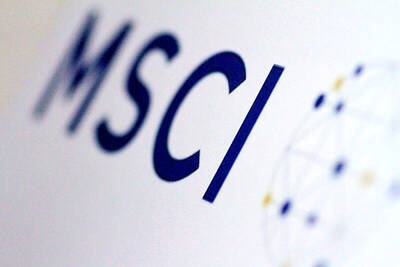The US on Monday invited Mexico to join a multibillion-dollar push to boost semiconductor manufacturing to compete with China, during a visit by US Secretary of State Antony Blinken for high-level economic talks.
Officials set aside trade tensions over Mexican President Andres Manuel Lopez Obrador’s energy policies, and focused instead on the potential benefits from cooperation in microchips and other technology.
The Creating Helpful Incentives to Produce Semiconductors and Science Act, which US President Joe Biden signed into law last month, includes about US$52 billion to promote production of microchips.

Photo: AFP
“Now in China and Taiwan the testing, packaging and assembly industry for semiconductors is a US$60 billion industry. In North America it’s US$3 billion,” said US Secretary of Commerce Gina Raimondo, who accompanied Blinken.
“So we’re really very excited about the opportunities for job creation in Mexico and in the United States,” she added.
“The opportunity for Mexico is not just in the manufacturing facilities, but in testing, packaging and assembly,” Raimondo told reporters.
Mexican Minister of Foreign Affairs Marcelo Ebrard welcomed the US offer to cooperate in semiconductors as “very generous.”
The two sides struck a conciliatory tone when asked about Lopez Obrador’s energy reform efforts, which face opposition from the US and Canada.
Washington in July filed a formal complaint against Mexico under a North American free trade agreement, saying its energy policies discriminated against US firms.
“Dispute settlement under international agreements is a normal part of trade relationships even among the closest of partners,” Blinken said.
“We’re moving full speed ahead in the further integration of our economies and in building the most competitive region in the world. And we’re doing that as you heard through the work on supply chains, on strengthening the work we’re doing together in building a clean energy economy, the work on semiconductors, etc,” he added.
Earlier, Lopez Obrador welcomed the tone of a recent letter from Biden, saying Mexico appreciated its “respectful attitude” compared with the trade complaint, which he described as “not the most diplomatic.”
Lopez Obrador’s push to roll back the effects of liberalization that he says benefited private companies has alarmed foreign investors and environmentalists, who see the moves as favoring fossil fuels over renewable energy.
Washington has requested consultations about the energy dispute under the US-Mexico-Canada Agreement, the first step in a process that could lead to retaliation over actions it says harm US firms and impedes development of clean energy.
Blinken met with Lopez Obrador ahead of the economic talks and discussed issues including cooperation to deal with irregular migration and the synthetic opioid fentanyl, the US Department of State said.
“They also spoke about joint efforts to tackle the climate crisis through investments in clean energy and emerging technologies like electric vehicles, solar technologies, and semiconductors,” a statement said.

PERSISTENT RUMORS: Nvidia’s CEO said the firm is not in talks to sell AI chips to China, but he would welcome a change in US policy barring the activity Nvidia Corp CEO Jensen Huang (黃仁勳) said his company is not in discussions to sell its Blackwell artificial intelligence (AI) chips to Chinese firms, waving off speculation it is trying to engineer a return to the world’s largest semiconductor market. Huang, who arrived in Taiwan yesterday ahead of meetings with longtime partner Taiwan Semiconductor Manufacturing Co (TSMC, 台積電), took the opportunity to clarify recent comments about the US-China AI race. The Nvidia head caused a stir in an interview this week with the Financial Times, in which he was quoted as saying “China will win” the AI race. Huang yesterday said

Nissan Motor Co has agreed to sell its global headquarters in Yokohama for ¥97 billion (US$630 million) to a group sponsored by Taiwanese autoparts maker Minth Group (敏實集團), as the struggling automaker seeks to shore up its financial position. The acquisition is led by a special purchase company managed by KJR Management Ltd, a Japanese real-estate unit of private equity giant KKR & Co, people familiar with the matter said. KJR said it would act as asset manager together with Mizuho Real Estate Management Co. Nissan is undergoing a broad cost-cutting campaign by eliminating jobs and shuttering plants as it grapples

The Chinese government has issued guidance requiring new data center projects that have received any state funds to only use domestically made artificial intelligence (AI) chips, two sources familiar with the matter told Reuters. In recent weeks, Chinese regulatory authorities have ordered such data centers that are less than 30 percent complete to remove all installed foreign chips, or cancel plans to purchase them, while projects in a more advanced stage would be decided on a case-by-case basis, the sources said. The move could represent one of China’s most aggressive steps yet to eliminate foreign technology from its critical infrastructure amid a

MORE WEIGHT: The national weighting was raised in one index while holding steady in two others, while several companies rose or fell in prominence MSCI Inc, a global index provider, has raised Taiwan’s weighting in one of its major indices and left the country’s weighting unchanged in two other indices after a regular index review. In a statement released on Thursday, MSCI said it has upgraded Taiwan’s weighting in the MSCI All-Country World Index by 0.02 percentage points to 2.25 percent, while maintaining the weighting in the MSCI Emerging Markets Index, the most closely watched by foreign institutional investors, at 20.46 percent. Additionally, the index provider has left Taiwan’s weighting in the MSCI All-Country Asia ex-Japan Index unchanged at 23.15 percent. The latest index adjustments are to